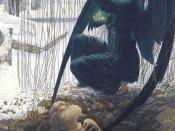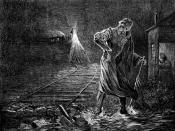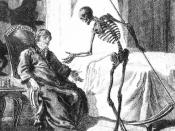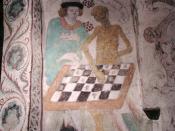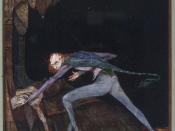An Obsession with the Inevitable: Death Edgar Allen Poe's "The Tell-Tale Heart"ÃÂ is a story about a man so obsessed with and terrified by thoughts of his own death, that in a deranged state of mind, he kills an innocent man. The murder, though premeditated, is committed by an insane man in a desperate attempt to escape what he sees as the ever-present watchful eye of Death. With the murder comes a brief reprieve from the terror that plagues the killer's mind. His sense of relief is short lived. Though his mind is clearly not sound, it is not so far gone that it can long maintain the illusion of having escaped death. Poe's selection of the first person narrative for telling his story effectively reveals to the readers both the unbalanced state of mind of the killer and, in a subtle manner, the killer's all consuming fear of death.
The killer's obsession with death is made most clear in the sixth and seventh paragraphs as he empathizes with the old man, recounting how many a night he has waited in mortal terror as he felt death approaching (63). This style of narration tends to pull the readers in and, to some extent, forces them become one with the narrator. (Although the sex of the narrator is never defined, I will default to a male reference in my writing.) Placing us inside the mind of the killer, who is also the protagonist, Poe allows us to sense the killer's madness, feel his feelings, and participate in his actions. This is a particularly effective means of providing the readers with enough information to decide for themselves what drives the killer to murder. The killer's reference to the death watch bugs tells us that he views them as a harbinger of his own impending doom. In the first line of the story, the killer tells us that the murder has changed nothing; "dreadfully nervous I had been and am"ÃÂ (62). What makes him nervous that was there before the murder and remains still? Death! The characters are developed in a manner that does not distract the reader from the central theme of the story. No visual description of the killer is given and none is needed. Instead, he is described only through our insights into his thoughts, perceptions, and emotions. His moods are erratic. Even when no action is taking place, you have a feeling of uneasiness. He reasons but is not rational. His protests against being judged mad convince you that he is. The only subject that occupies his mind is death. The other characters in the story are the old man and the police. The police play only a minor role and are described in no real detail. The only physical details we are given regarding the old man are communicated through the killer's reference to him as the "old man"ÃÂ, and the description of his vulture eye (62). Both of these descriptors are closely associated with death. Age brings us naturally closer to death. Vultures feed on the dead. The description of the eye, being "pale blue, with a film over it"ÃÂ (62) is consistent with the appearance that the eyes of the dead take on. We are given a sense of the old man's character in relation to the protagonist in our being told that the old man had never wronged him nor given him insult (62). These details are not provided to deepen our understanding of who the old man was. They serve only as clues in our quest to understand why the killer killed. The killer seems to think that the old man's vulture eye, his Evil Eye, is Death and that it keeps a watch on him during the day. Death and the Evil Eye are synonymous.
Capitalization of the two implies some personification of death. Instead of being viewed as a natural occurrence, death is seen as a being that stalks its prey. The killer in this story is clearly obsessed with, and perhaps even driven to madness by, the terror brought on by an unceasing anticipation of his own death. We come to understand that he somehow thinks he can escape death by killing the old man. He seems, briefly, to believe that he has accomplished this. His feelings of having triumphed over death are best expressed when the police come to the door after the murder. It is then that the killer suggests that he no longer has anything to fear. Some readers might view this statement as a reference to the murder that he has so cunningly concealed. I believe instead that this is an expression of the killer's feeling that he has vanquished Death. In the end, the beating heart, the tell-tale heart, is not some twisted sense of conscience that brings him to confess. The beating heart (likely his own though perceived by him to be the heart of his victim) is a tell-tale, a sign, that Death continues to stalk him.
